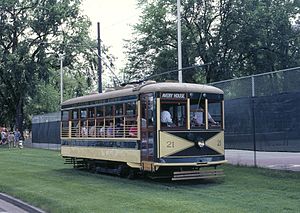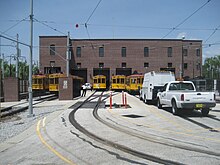Birney Safety Car

The Birney Safety Car , even Birney Car , Birney or safety car , a tram - railcars , the two types from 1915 to 1930 in the United States was made.
history

The vehicle was developed between 1910 and 1915 by engineers Charles O. Birney and Joseph M. Bosenbury. Their intention was to create a small and light tram car that would reduce the costs for infrastructure and personnel compared to conventional vehicles with high traffic density. As a result of standardization, the railcars could be produced inexpensively in large numbers. The low purchase price and the lower follow-up costs led to the widespread use of robust vehicles. By 1930, more than 6,000 copies of the two-axle design were built by various manufacturers. It was the first mass-produced streetcar in the United States. The most important manufacturer was the American Car Company , a subsidiary of the JG Brill Company .
In 1920 the highest annual production was achieved with 1699 railcars. The vast majority of deliveries were made to operations in North America , including Canada , Mexico and Cuba . But also companies in Australia (eight vehicles), New Zealand (built the wrong way round due to left-hand traffic in both countries) and Argentina received Birney Safety Cars. Vehicles have even been delivered to Europe, three railcars were used by the Gemeente Electric Tram Arnhem (GETA) in the Netherlands . Vehicles acquired second-hand finally made it to Ecuador and Colombia .
Production ended in 1930. The lack of smoothness in the short, two-axle vehicles had increasingly become a comfort problem. On increasingly poorly maintained routes, the derailment frequency increased; after snowfall, heavier vehicles were superior. On busy routes and during rush hour, the capacity of the small railcars was often insufficient. They migrated to subordinate routes or were sold to smaller towns. In Arnhem , the driving characteristics of the cars were evidently not satisfactory either, and the single entry slowed down the change of passengers. The GETA cars were sold in 1931 and converted into sidecars.
In the 1920s, an extended design was created. The car body of this four-axle vehicle rested on two bogies . The Texas Interurban Railway only used this type of vehicle with an upscale interior and toilets in inter-city traffic.
description
Unlike the tram vehicles of the time with two bogies, the original vehicle was two-axle and shorter. The resulting weight saving was around a third, which is one of the reasons why the costs for route maintenance were reduced. Two traction motors helped him achieve good acceleration values. It was an average of 8.5 meters long and had 32 seats.
The railcars were designed for operation without conductors, this development was favored by the shortage of personnel in the First World War . The doors were closed pneumatically.
The term Safety Car (dt. Safety car ) results from the fact that the doors were locked while driving. It was not possible to drive off if the doors were not locked. In addition, the vehicle had a dead man's device which interrupted the power to the traction motors if the driver let go of the control lever.
Whereabouts


There are several examples on display in tram museums in North America. Drivable railcars exist u. a. in the museum and tourist trams of Dallas (McKinney Avenue Transit Authority), Fort Collins (Fort Collins Municipal Railway), Fort Smith (Fort Smith Trolley Museum), Perris (Orange Empire Railway Museum), Tampa ( TECO Line Streetcar System ) and in Nelson, Canada (Nelson Electric Tramway). In Australia ( Bendigo , St Kilda , Melbourne ) and New Zealand ( New Plymouth , Christchurch ) vehicles, mostly drivable, have been preserved.
The four-axle design has been reproduced by the Gomaco Trolley Company since 1999 for some streetcar operators in the USA in at least 18 copies, in a slightly different form. They are used in Tampa, Little Rock and Memphis , among others . An original vehicle is being refurbished in Tampa, it is the only remaining one of the longest design.
List of museum vehicles (incomplete)
Australia
- Bendingo: Tw 30 (two-axle, one pantograph ; formerly Adelaide Tw 301), travels on the museum tram
- Bendigo: Tw 302 (two-axle, a pantograph; formerly Adelaide, later Geelong ), travels on the museum tram
- Melbourne: Tw 303 (two-axis, one pantograph; formerly Adelaide), in the St Kilda Tramway Museum
- Melbourne: an operational tw in the Hawthorn Tram Depot
Canada
- Nelson: Tw 400 (two-axis, two pantographs; formerly Victoria ), in refurbishment
New Zealand
- Christchurch: Tw 15 (two-axle; formerly Invercargill ), runs on the museum tram
United States
- Colorado Springs: Tw 135 (formerly Fort Collins Tw 22), being refurbished in the Pikes Peak Historic Street Railway Museum
- Dallas: Tw 686 (two-axle, two pantographs) can be driven
- Fort Collins: Tw 21 (two-axle, two pantographs; formerly there) runs on the museum route of the Fort Collins Municipal Railway Society
- Fort Smith: Tw 224 (two-axle, two pantographs; previously ibid), drivable in the Fort Smith Trolley Museum
- Pensacola : a biaxial tw exhibited in the Museum of Commerce
- Perris: Tw 10 (two-axle, one pantograph; formerly Pacific Electric), runs in the Orange Empire Railway Museum there
- Rio Vista: Tw 62 (two-axle, two pantographs; formerly Sacramento Northern), operable in the Western Railway Museum
- Tampa: Tw 163 (two-axle, two pantographs; previously there), drivable with the TECO Line Streetcar System
- Tampa: Tw 402 (four-axis, pantographs; formerly ibid), in processing
gallery
Fort Collins Birney Car 21
Carriage 62 of the Sacramento Northern Railway in the Western Railway Museum , Rio Vista
Web links
- Homepage of the On-Line Birney Safety Car Museum
- The Birney Safety Car at American-rails.com
- Gomaco Trolley Company website
- APTA Streetcar and Seashore Trolley Museum website
- Nelson Electric Tramway Society website
- Railcar 686 in Dallas on the turntable, putting on the power pole, approach (on Youtube)
Individual evidence
- ↑ The Birney Safety Car at American-rails.com ( Memento of the original from February 3, 2014 in the Internet Archive ) Info: The archive link was inserted automatically and has not yet been checked. Please check the original and archive link according to the instructions and then remove this notice. , accessed January 26, 2014
- ↑ a b De electrical trams van Groningen, Arnhem en Nijmegen, Publishers Wyt, Rotterdam 1971
- ↑ History - Tampa Streetcar # 402 with photo from the time it was in use ( memento of the original from January 2, 2014 in the Internet Archive ) Info: The archive link was automatically inserted and not yet checked. Please check the original and archive link according to the instructions and then remove this notice. , accessed January 27, 2014
- ↑ Blickpunkt Tram 1/2014, p. 145





